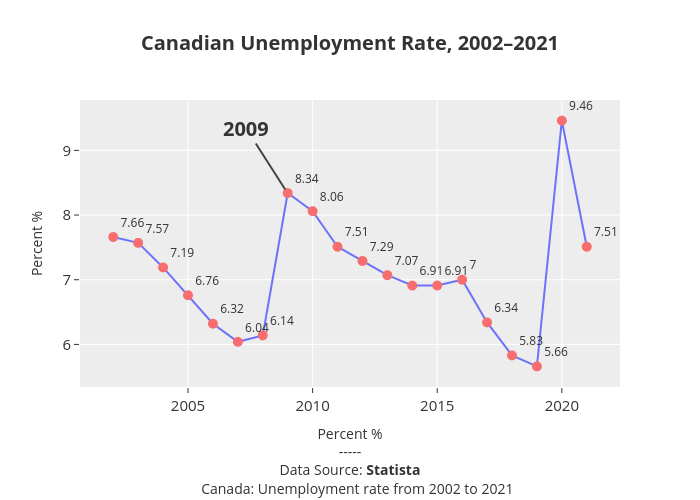8.0 Introduction
Learning Objectives
At the end of this chapter, learners will be able to:
- Explain the Aggregate Expenditure Model
- Determine the Level of Aggregate Expenditure in the Economy
- Define Macroeconomic Equilibrium
- Identify the Multiplier Effect
The Great Recession of 2008–2009 hit the U.S. economy hard. The Canadian economy was also severely affected. According to Statistics Canada, the unemployment rate in Canada rose to 8.7% in August 2009. Canadian productivity and output fell as well. Job losses, declining home values, declining incomes, and uncertainty about the future caused consumption expenditures to decrease. Canadians tightened their belts in the face of the weak economy, cutting spending on discretionary items or postponing outlays that weren’t immediately necessary, as reported by Statistics Canada.

Graph Data Table
| Year | Percent |
|---|---|
| 2002 | 7.66 |
| 2003 | 7.57 |
| 2004 | 7.19 |
| 2005 | 6.76 |
| 2006 | 6.32 |
| 2007 | 6.04 |
| 2008 | 6.14 |
| 2009 | 8.34 |
| 2010 | 8.06 |
| 2011 | 7.51 |
| 2012 | 7.29 |
| 2013 | 7.07 |
| 2014 | 6.91 |
| 2015 | 6.91 |
| 2016 | 7 |
| 2017 | 6.34 |
| 2018 | 5.83 |
| 2019 | 5.66 |
| 2020 | 9.46 |
| 2021 | 7.51 |
The meltdown in the financial markets called for immediate action by the Federal Government to help millions of people by extending unemployment benefits. The recession affected millions of people, cutting back on spending, filing for unemployment, and losing homes.
What caused this recession, and what prevented the economy from spiralling further into recession? Policymakers looked to the lessons learned from the Great Depression of the 1930s and the models developed by John Maynard Keynes to analyze the causes and find solutions to the country’s economic woes. The Keynesian perspective is the subject of this chapter.
Attribution
“Introduction to the Keynesian Perspective” from Principles of Economics by OpenStax-Rice University is licensed under a Creative Commons Attribution 2.0 license except where otherwise noted.

